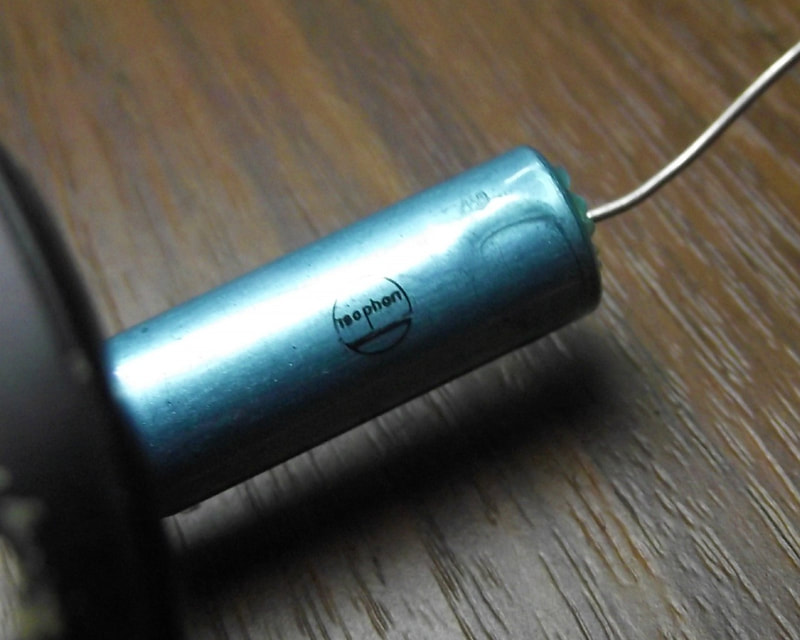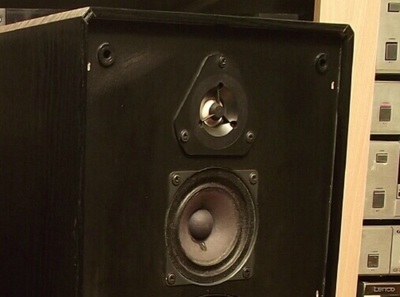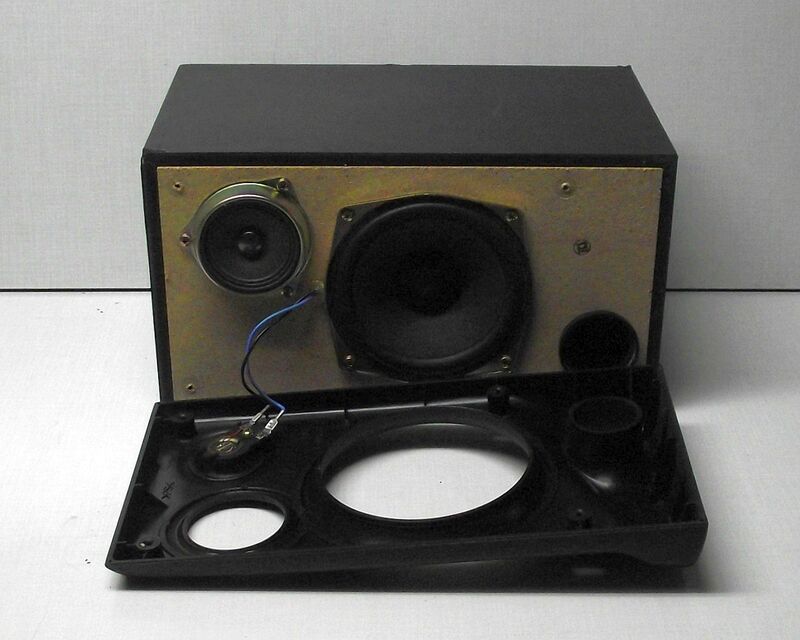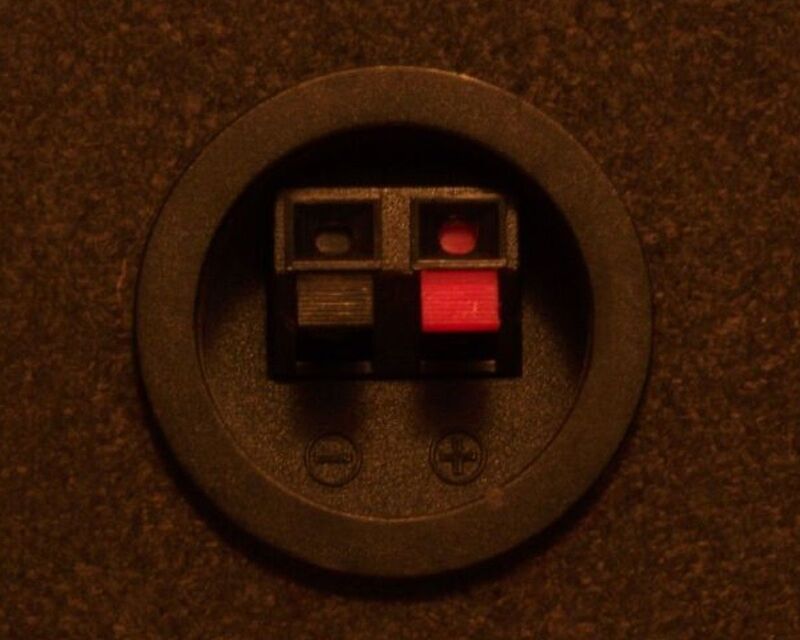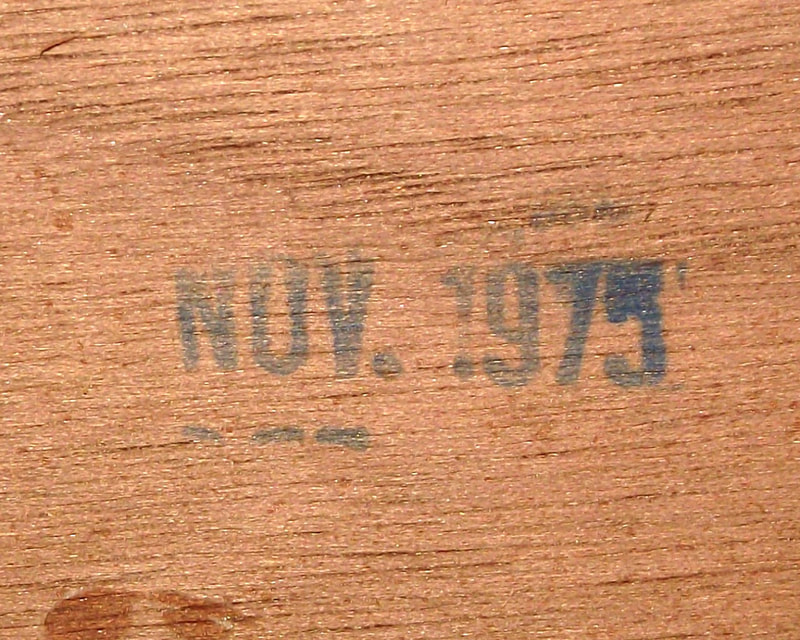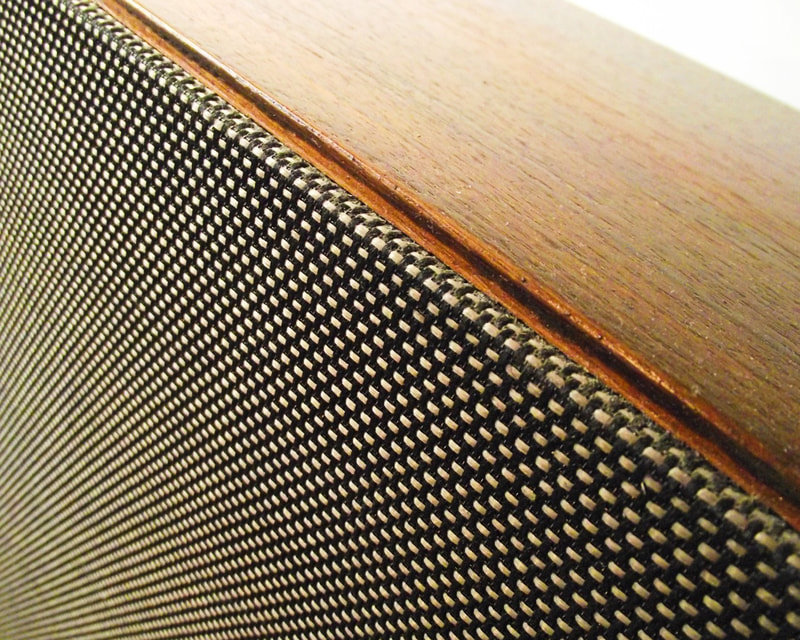HITACHI LS-230 (1976)
Introduced in 1976 the LS-230 from Hitachi, presented here, is a compact 2-way bookshelf loudspeaker. Made for the European market, the LS-Series loudspeakers were manufactured in Germany by Isophon. Isophon was a well-known manufacturer of loudspeakers for home applications as well as for commercial purposes, for example for sound reinforcement in train stations, football stadiums, cinemas, department stores and trams. By 1979 Isophon had produced more than 70 million loudspeaker chassis. The Hitachi LS-230 loudspeakers have the enclosure identical with the Isophon models, even the sticker at the back has the same design on both the Isophon and Hitachi models. Only the front grill has a different fabric and the crossover used in the Hitachi is a simpler 6db/oct. construction for the tweeter. (The Isophon models had 12db/oct. crossovers). Regardless of its simplicity the LS-230 is equipped with quality speakers, a 19mm dome tweeter and a 203mm woofer with rubber surround. The LS-230 has a sealed construction with an extremely well-built enclosure with sealed joints, sealed mounting of the tweeter and woofer, sealed backpanel and acoustic foam. The front fabric on this model is not removable, it's part of the box, glued and sealed. With this type of construction, it is the backpanel that's removable and the speakers are mounted from behind the front baffle. Power rating is a modest 20W continuous, 35W short term (music power), impedance is 4ohm, frequency response is 40-20000 Hz. Dimensions 440x250x190 mm. An interesting detail. The Hitachi badge on the front can be rotated which means the badge will always be horizontal regardless of vertical or horizontal placement of the loudspeaker.
Cover Photo Art: Wave Riders - Published January 15th 2022
Cover Photo Art: Wave Riders - Published January 15th 2022
HITACHI LS-370 (1980)
This is the matching loudspeaker to the HITACHI SDT-900M music center. It is a three-way closed "STUDIOKOMPAKTBOX" that was made in Germany. (West Germany). The bass driver uses a 203 mm (8 in.) paper cone, the midrange is a 100 mm (4 in.) paper cone and the tweeter is a dome made by Isophon (German speaker specialist). The crossover uses a simple 6 db/oct. filter or a 50-watt nominal and 70-watt music power loudspeaker. For more about HITACHI and the STD-900M music center see the SYSTEM page.
HITACHI HS-560 (1989)
Another big black box, from HITACHI. This loudspeaker was part of the MD-05CD/50 midi hi-fi system. This system had a special construction featuring a 4-way amplifier. For this reason, this loudspeaker has a special construction. The box is separated inside in two where the lower section is for the bass speaker only and the upper section has the bass-medium and tweeter units. The two sections were wired separately to the amplifier. (Bi-amplified system). The nominal power is 50W while the musical power is 70W in an 8-ohm construction.
JVC SP-C33BK (1994)
The JVC SP-C33BK is a loudspeaker that was part of the MX-C33 Compact Component System introduced in 1994. Technically this is a 3-way loudspeaker system in a mirrored image construction (loudspeakers are marked as Left and Right), which is a nice touch as most mass-market products did not follow this rule. Most of the times loudspeakers were built identical. The SP-C33 is a bass reflex construction with a 13,5 cm bass driver, 6 cm midrange and 2 cm tweeter that can handle 30 watts. While technically this construction could be called a 3-way loudspeaker the use of a "dome piezo" driver as a tweeter makes this loudspeaker more a 2-way speaker with an extra tweeter. As usual with this type of loudspeakers the "sculpted plastic front" is nothing but a decorative element mounted in the front of a conventional loudspeaker box. As you can see, the piezo tweeter is mounted directly to the plastic front, while the 6 cm midrange has a special housing so that it will nicely fit behind the plastic front. While this construction creates a nice visual appearance it is technically wrong. Actually, the midrange and the tweeter should be mounted further back from the front for correct time alignment of the loudspeakers. While the loudspeaker is well built and has a pretty decent bass response for its size, the mid-high range lacks sparkle. Dimensions 183x329x243 mm | Impedance: 6 Ohm | Weight: 3kg.
Cover Photo Art: All That Jazz - Updated January 2022
Cover Photo Art: All That Jazz - Updated January 2022
PHILIPS 2016 (1927)
Pre -"High Fidelity International" speaker from PHILIPS.
This very old loudspeaker came from my grandparents, and it was made by PHILIPS in 1927. Having this "inverted dome" shape was also known as the "Chinese hat". It can be placed in various positions as you can see in picture #2 - on the wall, hanging from the ceiling, on a table. It was used as a separate (component) speaker to several radio models.
This very old loudspeaker came from my grandparents, and it was made by PHILIPS in 1927. Having this "inverted dome" shape was also known as the "Chinese hat". It can be placed in various positions as you can see in picture #2 - on the wall, hanging from the ceiling, on a table. It was used as a separate (component) speaker to several radio models.
PHILIPS RH 402 (1973)
"Never judge a book by its cover" they say. This is also true with this small loudspeaker from PHILIPS. By looking at, it might feel a simple, cheap loudspeaker with poor performance. The truth is that this little box sounds quite good. Inside a real wood veneer box is a two-way speaker system with high quality components. It is a sealed box filled with damping material. This was part of the "serious" components PHILIPS was making with the "High Fidelity International" logo on it. Power rating is 20 watts with an impedance of 4 ohm. This model was manufactured in Finland. For more about a "High Fidelity International" setup see the SYSTEM page.
PIONEER CS-797 (1985)
Big black box from Pioneer, a lifestyle loudspeaker originally sold in 1985 as part of the X-A707 component Hi-Fi system. Very attractive front styling but only basic construction. This 3-way bass-reflex loudspeaker consists of a 20cm woofer, 7.7cm midrange and a 6.6cm tweeter. The tweeter has an Acoustic Lense in front of the paper cone tweeter. Crossover frequencies are at 3000Hz and 4000Hz. Music power rating is 110W with a frequency range of 40-20K (Hz) and its impedance is rated at 6-ohm. The removeable front cloth adds extra protection if needed. No internal damping is used and for best results you need a good, matching amplifier to handle-it. We have had good results with the Bang & Olufsen BEOMASTER 2200 from our collection.
Cover Photo Art: Long Distance Traveler - Updated October 2023
Cover Photo Art: Long Distance Traveler - Updated October 2023
SCHNEIDER LB 114 (1975)
The SCHNEIDER LB 114 is a loudspeaker set manufactured in W.Germany in 1975 (...November to be more accurate). It is a "classic" two-way bass reflex construction that utilize a speaker set sourced from WESTRA, a German speaker manufacturer. Westra as a company still exists today but they no longer manufacture loudspeakers. The loudspeaker manufacturing facility was taken over by HKM ElektroAkustic Germany. The following drive units are used by the LB 114: Westra SW-200-1301 20cm diameter woofer and the Westra ST-77-302 77mm diameter paper cone tweeter. Both drivers have a nominal impedance of 4 ohm and are working with a first order crossover network that consists of a inductor for bass and a capacitor for the tweeter. The bass reflex port is a simple hole on the front panel behind the fabric. The box itself is a very solid construction with typical 70s assembly details. This means that the front covered with a thick fabric is glued into the box while the drive units are mounted from the back. This means that the back cover is sealed and mounted into place with screws as a removable panel. As usual with German products of this era the loudspeaker cable is a captive lead with DIN speaker plug termination. The external finish is real wood veneer!! It is worth noting that some versions contain Westra drive units marked as Made in Japan while the loudspeaker was also sold under different brand names as well (e.g., Hanseatic). While the technical specifications are rather modest, these loudspeakers perform quite well when used with the Bang&Olufsen Beocenter 7007 from our collection. Technical data: Power 40W nominal/ 80W peak | Impedance 4ohm | Frequency response ...according to DIN 45500... | Dimension: 25x45x21 cm.
Cover Photo Art: Vintage Sound - Published July 15th 2022.
Cover Photo Art: Vintage Sound - Published July 15th 2022.
SIEMENS HiFi-STUDIOBOX RL 706 (1979)
This is a three way "compact" loudspeaker system from 1979. In those days even a loudspeaker with a 30 cm (12 in.) woofer was presented in the brochure as a "compact" loudspeaker. The tweeter and the mid driver were dome type. This was a trend of the moment, using "newly developed dome" speakers for the midrange. The "loudness" of both the tweeter and the mid unit were adjustable between 0 and -6 dB. For extra safety all the three loudspeakers had overload signaling LED's. Built as a sealed box they have a removable front cover that has a nice brushed aluminium decorative side strip.
See also the Technical data. You can see the matching SIEMENS system here.
See also the Technical data. You can see the matching SIEMENS system here.







